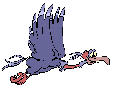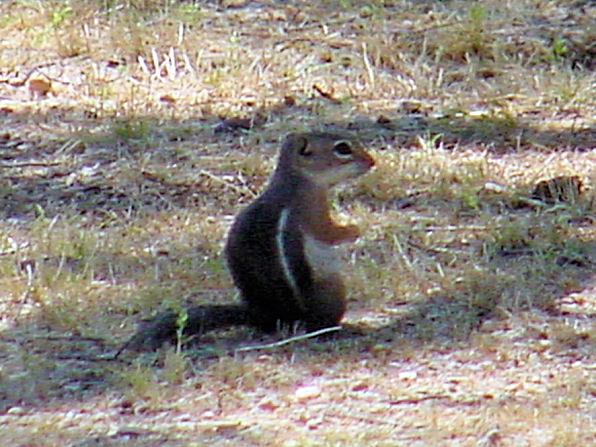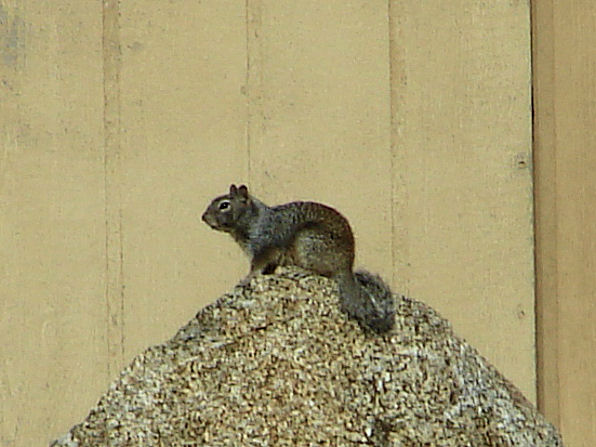

![]()


Wild Animals Of Yarnell, Arizona.
Scrub Oak, Pinyon Pine Forest, & Desert Environment
Butterfly Pictures, Photos, Images, & Reviews.
Where The Desert Breeze
Meets The Mountain Air!
George & Eve DeLange


We Are Proud Of Our SafeSurf Rating!
Click On Any Of The Following Links By Amazon.Com
For Books, & Videos About Wildflife Of Arizona & The Southwest USA. No Obligation!
There are numerous Wild Animals living in Yarnell, Arizona. Their numbers and varieties vary according to the seasons of the year. We will try to show you some of the Animals in the Yarnell area, on this page. Yarnell is located on the Highway 89, Scenic Route to Prescott, Arizona. Yarnell is also listed as one of the communities to visit along the American Heritage Trail route. There is a link to the Yarnell Chamber Of Commerce at the bottom of this page. Most of the images are taken from within 1 mile of downtown Yarnell, Arizona. This is clearly one of the best places in Arizona to easilly see animals. This is a beautiful, quiet, peaceful area, and that is one of the best kept secrets in Arizona. This page is a work in progress, so please come back for updates. Eve and George are not Animal Experts, so we probably won't be able to answer any technical questions about them. We have placed some general descriptions of the Animals shown on this page in a large text box located after you view all of the large images. The characteristics are in the same order as the large images. Please, let us know if you spot any errors on this page! We have already learned that the photography of Animals takes a lot of patience.
Now, we know that there are several definations for the word "Animal". But we chose to use a definition, which pertains especially to that of a mammal for this web page:
With that being said. We simply hope you enjoy our amateur efforts!
|
 |
| Collared Peccary, Pecari tajacu. Note The Light Brown "Collar" Of Hair Near The Neck. Photo Taken In Yarnell, Arizona. March 31, 2009. |
|---|
 |
| Small Herd Of Collared Peccary, Pecari tajacu. Walking Along A Trail, Near The Community Roadway Photo Taken In Yarnell, Arizona. March 31, 2009. |
Javelina or Collared Peccary, Pecari tajacu or Tayassu tajacu:
While Javelina originated in the South American rainforests, the Javelina in Arizona have adapted, and are expert desert-dwellers, foraging in social groups of 2 to 20 during the early mornings and evenings, then sleeping in the shade of mesquite trees and rock outcropings during the heat of the days. The two javelina on this page have a nice "home"located under the porch of an occupied Yarnell home, without a fenced yard. Javelina are most often found in the low to mid-level deserts and desert grasslands between about 1,000 to 5,000 feet in elevation. Their marginal habitat includes the pinyon pine, juniper oak, and pine oak vegetation communities between about 4,000 to 7,000 feet in elevation. Of course; Yarnell is a juniper oak, vegetation, riparian community of about 4,800 feet. The word Javelina comes to us from the Spanish word "javelin", (prounounced: ha vel EEN), meaning spear, a reference to their long, pointed canine teeth. They do look like small, hairy pigs, with bulky bodies on short legs with tiny three-toed hooves. Their hair is long and bristly, with spiky ruffs around their necks and sometimes on top of their heads. The baby javelina, or piglings, do look like domestic piglets, except they have a lot of hair. Javelina form herds of two or up to as many as 20, and they rely upon each other to defend their territory, to protect themselves against predators, and to socially interact with each other. One of the most amusing interactions is to watch the mothers pushing their piglets through the streets and past the houses of Yarnell! Javelina use local washes and areas of dense vegetation as travel corridors. Javelina are most active at night, but they can also be active during the day when it's cold. Javelina, or collared peccaries, have a sharp sense of smell and relatively poor eyesight. And speaking of smell; they have a gland at the base of their tails that is used to mark trees, rocks, and even each other with a sharp, musky scent similar to that of a skunk. The smell also helps each javelina to identify members of their herd. Strolling through the Arizona low or high desert, you'll often smell a Javelina before you see one. They sometimes are called a "musk hog" because of the very strong odor they release, especially when alarmed. Speaking of marking their territory, Javelina have small home ranges of about 4 square miles in area. Once found, they'll usually remain in the same general area. That's one reason, we see them so easily in Yarnell. Javelina average about 1 1/2 feet at shoulder height and are about 3 feet long from nose to tail. Their average weight ranges from about 40-60 pounds. Adult males are usually about 10 - 15 pounds heavier than females. New born javelina weigh about one pound, the baby Javelina continues to grow until they reach their adult height after about 10 months. They then are able to breed. Breeding usually takes place in January, February, and/or March. There is a 145-day gestation period, so most births occur in either June, July, or August. This birth also corresponds with the maximum rainfall period. Two is the most common number of young piglets; however they can have up to four. The young follow their mothers to learn their habits shortly after birth. They are usually weaned at about six weeks of age. Javelina are usually considered herbivores; although they will occasionally eat insects and the occasional lizard. They love to eat prickly pear cactus, agave, and other spiny or succulent plants; including the roots, tubers, forbs, and pods. Their main preditor is the coyote. Mountain lions and bobcats also get their share. Coyotes and golden eagles are the greatest preditor of baby javelina. They have become used to human beings, and they usually live in harmony with people. However, the braver Javelina are not above rummaging through a trash can or into a nice looking garden. If a javelina feels threatened, it will stamp, snort and clatter its jaws together and it might charge at a perceived threat. They also are known to put the family dog in its place if threatened by the dog. We advise keeping javelina and dogs seperated. People should NEVER feed javelina; this can cause them to become regular visitors and to lose their fear of people, creating problems for the entire neighborhood. If attracted to a neighborhood, javelina can take shelter under a porch, a mobile home, or a crawlspace beneath a house. This would make it necessary to have removal as a last resort. Most javalina do not survive removal. In Yarnell, we have a small sized herd that seems to live within the town boundaries almost all of the year.
|
 |
| Mule Deer, Odocoileus hemionus. Photo Taken In Yarnell, Arizona. September 24, 2008. |
|---|
| Mule Deer, Odocoileus hemionus. Photo Taken In Yarnell, Arizona. September 24, 2008. |
Mule Deer, Odocoileus hemionus:
The mule deer is the largest of the Odocoileus genus, standing, on the average, 40 to 42 inches at the shoulders and stretching 80 inches or so nose to tail. An adult buck will weigh from 150 to 300 pounds on the hoof, with the doe averaging 100 to 175 pounds. The Mule Deer are so-named because of their large mule-like ears. They have a white patch on their rump, with a small tail that is white with a black tip. They shed their hair twice a year, leaving a fine reddish brown coat in the summer months, and a coarse, grayish coat in the winter. The bucks (males) have a darkened v-shaped area on their forehead and dark chest coloring during the winter. The fawns have a reddish brown summer coat with white spots on both their back and sides. The spots disappear in about three to four months. Mule deer are not limited to any one type of terrain, they are commonly found from the sparse, low deserts to the high forested mountains. Generally they prefer the more rugged country. Mule deer prefer canyons, which they work their way down into open grasslands. They bed down in shrubby areas. They are less likely to use mature timber areas, but may be found in timber along the upper portions of streams and creeks. They are also fond of small grain, and alfalfa crops growing within their occupied range. They are most active during dawn and dusk, when they venture from their protective cover to feed. They feed on grasses and forbs in the spring and summer, however, they are primarily browsers. They eat such items as twigs, bark, buds, leaves, and nuts. Typical plants in a mule deer's diet include mountain-mahogany, juniper oak, buckbrush, cliffrose, sagebrush, and buckthorn. Most of these foods are found in Yarnell. In Arizona, their main predators are mainly coyotes, bobcats, and mountain lions. Several years ago in Yarnell; we saw a mountain lion chasing a mule deer. The lion was really surprised; when the deer jumped a fence, and the lion did not see the fence. The lion was soon tangled up in the fence, as the deer ran away! Their breeding season usually begins in October and ends during early February, the peak occurs during mid to late November. This is also referred to as the "rut", a time when the buck's neck swells and he fights other bucks for breeding dominance. The fawns are born after a 202 day gestation period, with about half of the young being born between late May and late June. The fawns become sexually mature in a year and a half. In the wild; deer have a life span of about ten years. In Yarnell, we have a small sized herd that seems to live within the town boundaries almost all of the year.
|
 |
| Harris' Antelope Squirrel, Ammospermophilus harrisii. Photo Taken At Bottom Of Yarnell Hill In Arizona. May 3, 2005. |
|---|
Harris' Antelope Squirrel, Ammospermophilus harrisii:
The range of the Harris� Antelope Squirrel ranges is across western and southern Arizona, and into southwestern New Mexico. It also is seen in the south to west - central part of Sonora, Mexico. The Harris�s Antelope Squirrel occupies low deserts often in association with rocky soils or rocky slopes, with cacti or desert shrubs. He may even sit on top of a cactus to look around. The Harris�s Antelope Squirrel is very agile, seen scampering over sharp - spined cholla cactus without being stuck. It also is well adapted to tolerate hyperthermia, often it is the only small mammal to be seen during the hottest parts of a summer day. The Harris�s Antelope Squirrel is Omnivorous, feeding on fruits and seeds and the occasional insect and mouse. It also carries its food in large cheek pouches to store in its burrows, or under rocks. They very often scurry around, collecting seeds, and storing them in their cheek pouches; until their body temperature climbs so much as to be nearly lethal, then they will duck back into the shade, very often lying flat on the cool soil, with their arms and legs spread eagle. When they cool down, they will go back out in the sun again. In the cold winter, they feed upon their stored underground food. They do not hibernate. They typically breed in December or January and have a litter of 5 to as many as 14 young (average 6), about a month later. The babies are born pink, with no hair, and with their eyes and ears closed. It is also known as the Harris's Spermophile, Marmot Squirrel, Gray - Tailed Antelope Squirrel, or Yuma Antelope Ground Squirrel. We have not observed this squirril within the town limits of Yarnell. But, just below Yarnell Hill, which is about 1,200 feet lower.
|
 |
| Rock squirrel, Spermophilus variegatus. Photo Taken At Yarnell, Arizona. November 29, 2008. |
|---|
Rock Squirrel, Spermophilus variegatus:
Rock squirrels are commonly found in rocky terrain. Yarnell is surrounded by very large granite boulders, so they love Yarnell. They have been known to make homes in old buildings as well as other structures. They love to place their dens in oak juniper woodlands, or riparian areas. Yarnell fits both of those criteria. The rock squirrel has speckled greyish-brown fur and a long bushy tail. They are the largest of the ground squirrels, weighing up to 1� pounds. Rock squirels are considered diurnal; which means that they are dormant during parts of the cold winter months. But, they are not known to hibernate since in the winter, they are known to occasionally come out on warm days to gather and store food, and then retire to their burrows. Spermophilus variegatus is an omnivore, feeding on seeds, mesquite beans, insects, eggs, birds, carrion, and fruits, such as from the prickly pear and barrel cactus. Rock squirrels usually mate early in the spring. The young squirrels are usually born in March; but they may have a second litter in August or September. Rock squirrels can be either colonial or solitary.
|
Links To Local Features & Attractions
We Are Proud Of Our SafeSurf Rating!

Click On Any Of The Following Links By Amazon.Com
For Books, & Videos About About Arizona Animals, Snakes, Insects, & Birds. No Obligation!
Click On Any Of The Following Links By Amazon.Com
For Books, & Videos About About Arizona Birds. No Obligation!
Click On Any Of The Following Links By Amazon.Com
For Books, & Information
About Desert Landscaping And Gardening. No Obligation!
Click On Any Of The Following Links By Amazon.Com
For Books, & Information
About Desert Landscaping And Gardening. No Obligation!
Link To Yarnell, Arizona Chamber Of Commerce Home Page
|
| Back To Arizona Tours Page
|
| Back To DeLange Home Page
|
